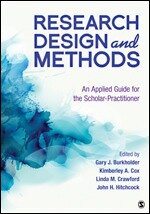Why did we write Research Design and Methods An Applied Guide for the Scholar-Practitioner?
Research and practice are the focus for December on SAGE MethodSpace, with featured posts from our Mentors in Residence, the co-editors of Research Design and Methods: An Applied Guide for the Scholar-Practitioner. Find the unfolding series of posts through this link. Enter the code SAGE2019 for a discount on your book purchase.
Why was this book so important to write? A roundtable with the co-editors.
Gary Burkholder
Gary Burkholder
All of us have been teaching scholar-practitioners for many years. At Walden University, where I teach, most of our students are not planning on being academic researchers. My background is research, and it was expected that, for me to be successful, I needed to take a lot of very complex statistics and design courses to develop my expertise. My students for the most part don’t have that need. Their goal is to learn the research in their area to become better practitioners, which means many different things to my students: To be better teachers, more effective managers, to grow company productivity and efficiency. Back when we conceived this text, there were really no books written for our kind of student. So, we decided that we needed to be the ones to write the book our student wanted and needed – a book that was simple to understand but still provided the essential skills needed to become doctoral-level researchers. And we knew we were the team to undertake this task.
Linda Crawford
Linda Crawford
As I have taught and mentored hundreds of students in the research process, I havefound a wide range of initial exposure to what is research. Some students already have quite advancedknowledge in the meaning, purpose, and conduct of research, but, for manystudents, research looms as some esoteric, quizzical, and nearly unknowablepuzzle. When this happens I often askstudents if they can drive. Theyuniversally respond that they have mastered this very complex skill. I assure them that if they have mastered thatskill, they can master research. I seethem breathe easier and relax.
Enter the code SAGE2019 for a discount on your book purchase.
Research Design and Methods
Brought to its simplest, research is simply answering aquestion in an orderly way and then sharing the answer. We all have been doing research most of ourlives. When we were little, maybe wewanted a new bike. We asked aquestion: what bike do I want? Then, we looked at the ads in the paper,talked to our friends, and looked at the bikes in the neighborhood; we gathereddata. Finally, we came to a conclusionas to what bike we wanted, and we told others what bike we wanted and why.
The job I wanted to do with the book was to help studentsraise the research skills they already have (perhaps unknowingly) to a higherlevel of sophistication, and I wanted to demystify research for students. Hopefully, the book attains those goals.
John Hitchcock
John Hitchcock
Readers of a certain age might remember a television series called “Fraser.” It had a good run, from 1993-2004 (and was a spin off from an older show called “Cheers”). One of the show’s characters, Dr. Niles Crane, played by David Hyde Pierce, played a psychiatrist who had many quirks. This made the character, who was meant to be brilliant and sincere, more approachable, which is a common theatrical device. In one episode of the show, this character briefly mentioned that he published some research in a journal. I thought this was interesting because his full time job entailed applied therapy work.
Filling in my own gaps, as audience members are prone to do, I decided that the fact that Dr. Niles Crane was publishing research was because he saw value in his work and others could learn from his efforts. Sure, there were elements of ego and pride in Dr. Crane’s motivation to conduct and publish research, but his most fundamental goal, I decided, was that he saw research as yet another way for him to help people. Whether the show writers truly meant to convey this is immaterial. What matters is I believe practitioners know a lot and they can share much. They can do their own research or be essential members of large research teams. Research is another way to give back, and to be helpful. When practitioners not only work on today’s problems via their service, but also tomorrow’s problems to help us be smarter and more efficient, I am convinced that the world becomes a better place. I strive to be a bit like my imagined version of Dr. Crane, and I hope others will try to do the same thing. I suppose this image is why I think this book was important to write.
Kimberly Cox
Kimberly Cox
We noticed a need for a research design and methods book written by scholar-practitioners for scholar-practitioners. This book is uniquely structured in six parts that guide readers through topics such as theory, research design, data collection, ethics, analysis, and writing about research. As a result, this book can serve as a research companion to advanced undergraduate students and graduate students throughout their academic journey, from their coursework to their thesis or dissertation research. For the current scholar-practitioner, this book can serve as a valuable companion to support their application of research as they bridge theory and practice in their professions.





